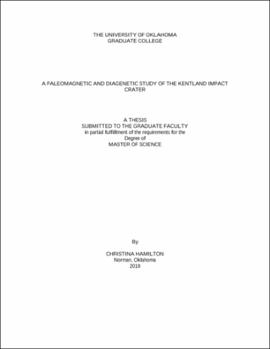| dc.description.abstract | A paleomagnetic and petrographic study of host carbonate rocks and impact breccias at the Kentland impact structure was conducted to better constrain the timing of the impact and to better understand the and diagenetic evolution of the rocks. Stratigraphic constraints can only constrain the impact to between 325 Ma and 50 ka, although a previous paleomagnetic study of the host carbonate suggested a tentative Late Cretaceous age.
Ordovician-Silurian target carbonates dominate and are largely wackestone/packstone with minor dolomite and abundant allochems. Polymict impact breccias occur as dikes and consist of dolomite crystals with some clasts of the host carbonate, as well as, sandstone, sphalerite, apatite, and rare coated grains which contain clays, dolomite, calcite and hexagonal silica resembling tridymite. The host carbonates contain brecciated zones near the polymict breccias that display suevite-flow textures of aligned minerals including apatite and gypsum which occur as authigenic elongated crystals. Iron oxides, such as magnetite, hematite and potential goethite are also found within brecciated veins.
Vuggy porosity is present in the breccias and is attributed to escaping CO2 that formed by sudden impact-related devolatilization. Porosity also occurs as partially to completely dissolved dolomite crystals as well as dissolved cement in sandstone clasts. These results suggest alteration by hydrothermal fluids, probably relatively soon after impact. Some breccias also show evidence of secondary hematite precipitation that occurs as cement and as replaced gypsum rosettes.
Alternating field and thermal demagnetization of impact breccia specimens removed two antipodal ancient components; one with southerly declinations and moderate negative inclinations and the other with northerly declinations and positive inclinations. Demagnetization of the host carbonates also removed these components. Isothermal remanent magnetization (IRM) acquisition, coercivity modelling of the IRM, and thermal decay of the IRM show both low and high coercivity materials are present which indicate that the magnetization resides in magnetite and hematite. The demagnetization results and rock magnetic studies suggest the magnetization resides in magnetite at intermediate unblocking temperatures, whereas at higher temperatures it resides in hematite. These are interpreted as chemical remanent magnetizations (CRMs) that formed from alteration by hydrothermal fluids. The paleomagnetic pole falls on the Late Triassic to Early Jurassic part of the apparent polar wander path which suggests the alteration in the breccias, and probably the impact, occurred in the Late Triassic to Early Jurassic. | en_US |
